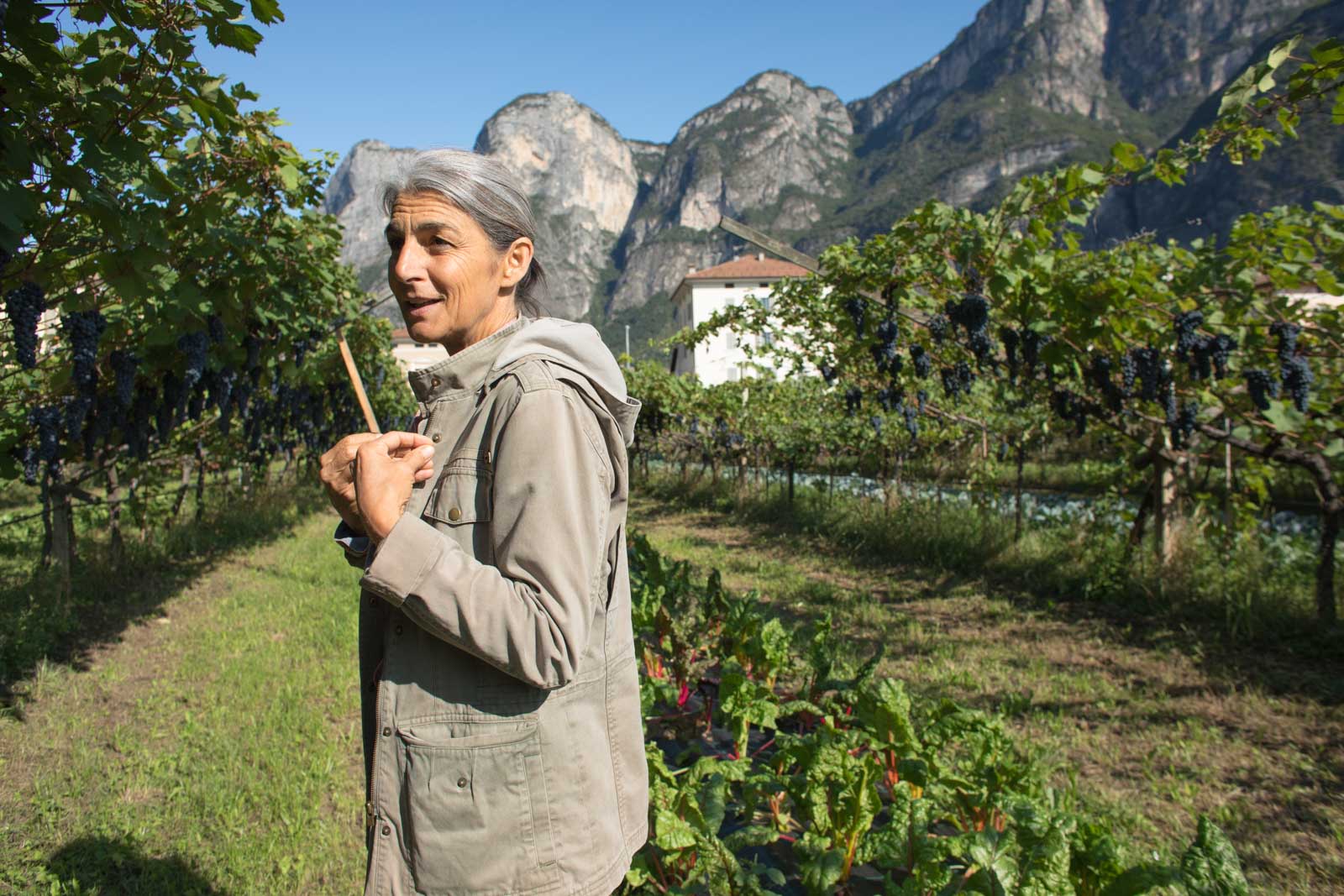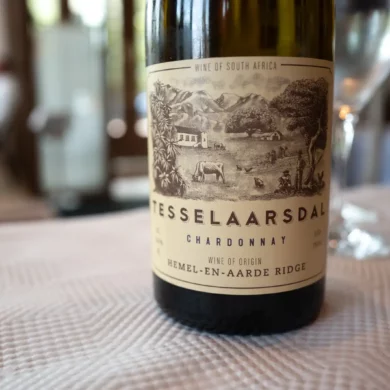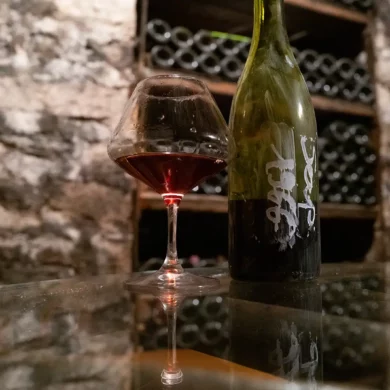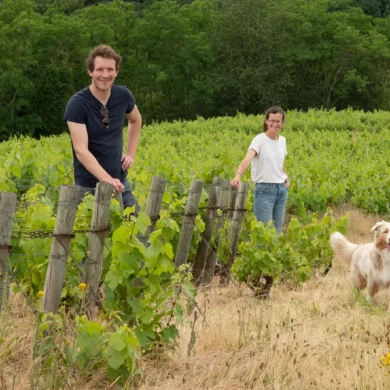“Would you like an espresso?” Elisabetta Foradori asked, shortly after my friend Clay and I walked through the door of her winery. It was 9am and the alpine light entering through the windows was soft and rich. The kitchen beyond, where she was leading us, looked like an inviting place to chat about wine. You are Elisabetta Foradori, I wanted to reply. If you are making espresso, of course, I will have one. (Alas, “yes, please” seemed like a more appropriate response).
A few days earlier, in Alto Adige, an editor of a major wine publication had told me that Foradori was a serious place. Subliminally, the message seemed to be ask good questions or they’ll send you on your way. Or maybe it was that is no place for a self-published “blogger” to land an interview. Clay, who freelance writes for several national publications, had been “warned” as well, but by a natural-wine focused sommelier: Have your act together. Know your stuff. Don’t waste Elisabetta’s time.
Where had these two industry insiders met Elisabetta? At crowded, noisy trade tastings in America. We were in her kitchen, and she was making us espresso. How lucky we were.
But as our conversation with the patron saint of the Teroldego grape began, I quickly saw how that message — that I should somehow be dumbstruck in her presence — was completely misguided. It is true that in many ways, Elisabetta is the opposite of so many Italian winemakers I’ve encountered, who disarm with self-deprecating humor and seem as delighted to charm a room as they are to please palates. Elisabetta is measured and precise with her words, while maintaining a fiery-eye contact that is difficult to break. She is more like the esteemed professor on campus with a reputation for demanding curricula.
I was at her winery to see her vineyards firsthand, to taste through her collection of wines, and to hear her story. The agenda was the same as any other winery visit. But I quickly felt like she was not going to let me leave without first challenging my understanding of the natural world around us.
“They said it was not possible to make good wine from our local variety”
The Foradori family winery was purchased by Elisabetta’s grandfather in the 1930s. Her father took over in the 1960s, but he died suddenly in 1976 when Elisabetta was only 12 years old, leaving the estate and its management to Elisabetta’s mother. At age 19, the winery became hers. She took over out of a sense of duty.
“In the ’80s to ’90s, it was the time when all Italian wine was moving into international varieties,” she reminisced. “They said it was not possible to make good wine from our local variety [Teroldego].”
Her starting point was a magnificent vineyard of pergola-trained Teroldego dating back to the 1930s. It became the perfect source material for a career obsessed with plant genetics. Her ex-husband — a German named Rainier Zierock — fostered this interest in the early days of her tenure, and before long, winemaking was about more than just making wine. “It was a very important time for me to put my energy into the genetic richness of the vineyard, which, for me now — still now — is the most important idea.”
Using the old vines to propagate new vineyards — a process called massal selection — became the first of her many salvos against the age of modernism in winemaking. Organic and biodynamic practices would be adopted in the early 2000s; use of clay vessels in the winery would follow shortly thereafter. Today, Foradori is rightly considered the exemplar of Trentino winemaking because of her Teroldego and Nosiola wines. But in those early days, according to her son Emilio, who has taken over a majority of the winemaking, she also planted Petit Manseng, Vermentino and even Grenache.
“In the 1980s, nobody wanted to drink Teroldego,” he told me over lunch. “My mom and dad said ‘let’s try other stuff. Maybe there is something interesting.’ But they stopped because they saw the potential for Teroldego was much better.”
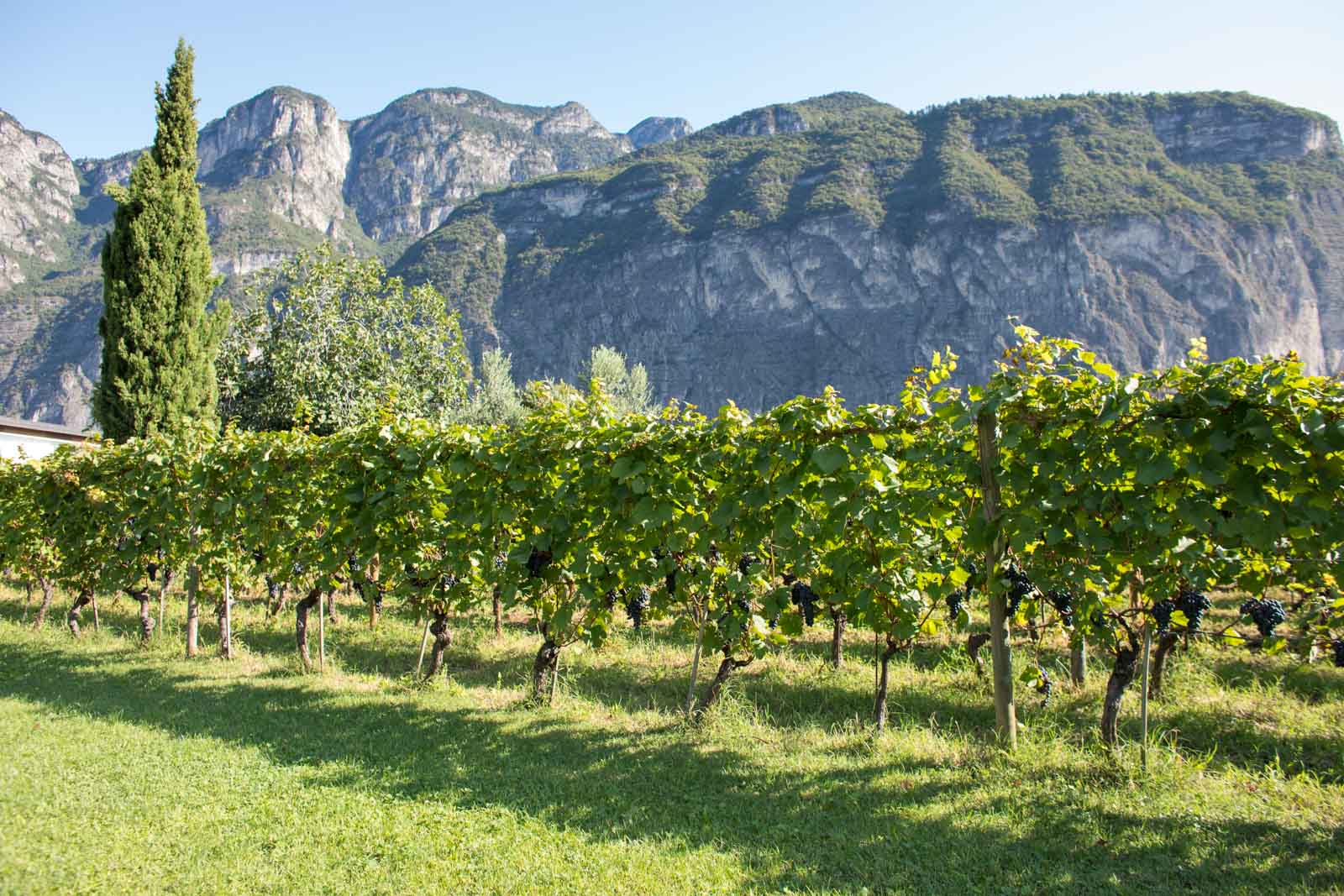
“It was a war on massal selection…”
Her breakthrough wine internationally was, and remains, the oak-aged Teroldego called “Granato,” which hails from the pergola-trained vines that engendered all of her other vineyards. The lesson was clear: a traditionally farmed local variety could break through the brashness of “the Parker Era.” But also this: genetically diverse vineyards made for more compelling wine.
“For my first 15 years — from 1982 into the nineties — it was a war on massal selection,” she said, speaking of the wine industry at the time. “Everything was cloned. This happened to all the varieties, and this was, for me, a disaster, because now if you plant a vineyard with only one clone — that’s mean. They are genetically the same.” She elaborated that a grapevine’s natural inclination is to adapt and mutate, and that these differences create more complexity across an entire vineyard.
We went outside to her Guyot-trained vines — the offspring of Granato. “This is my small forest of Teroldego,” she said with a subdued sweep of her arm.
Had this been winter or spring, I might not have noticed the difference, but because it was September and the berry clusters were growing plump, I could see how each vine’s performance varied. Some clusters were rounded, others more conical; some vines were twisted with stubborness, others rose to the wires more compliantly. We snitched a selection of individual berries from the vine, and even to my untrained, uninitiated-with-fresh-Teroldego palate I could taste slight variations. Very slight. This was not the vineyard of someone who wanted to make the same product every year; rather someone who wanted to capture nature’s voice and distribute it. I made a note: to understand Foradori’s wines is to understand every one of their vintages.
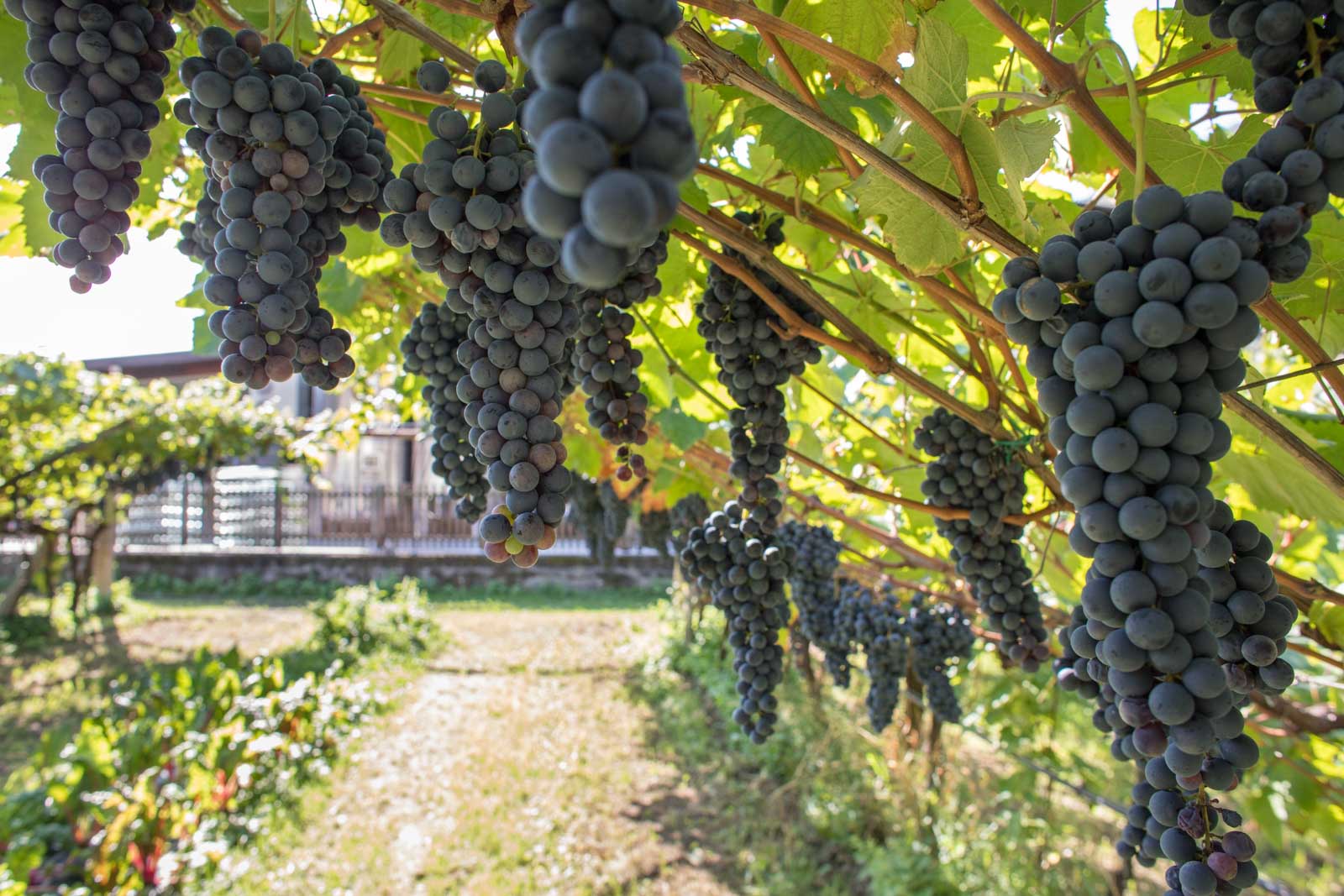
“The roots of the plants speak to each other…”
Tending such a vineyard naturally means more work and vigilance, but — in Foradori’s firm opinion — the toil is worth it because the vineyard is more resilient, especially when the practices are paired with biodynamic viticulture.
As we eventually reached the pergola-trained vines of the Granato vineyard, Elisabetta began to talk about the importance of biodiversity. Her daughter, Myrtha, is the family gardener, and in between the spacious rows of pergola vines are rows of vegetables. This practice of co-planting has a long history in Italy, and while Elisabetta described how the vegetable plants contribute to the ecosystem of the vineyard, I couldn’t help but notice that it was also, quite simply, a better use of space. In the 1930s, when the pergolas were erected, they were likely spaced out for this very reason. Now, on weekends during the growing season, Foradori sells produce, in addition to wine, from the front door.
Once again, Elisbetta returned to the idea of a forest: how every plant contributes to the stability and vitality of the soil, and how their interconnectedness leads to more resiliency against threats. I asked her to explain this further, and she was adamant: “A healthy forest, hundreds of different plants — you will never have a problem from maladies. Why? Because the roots of the plants speak to each other.”
At this, I thought of the lodgepole pine forests where I live in Colorado. Were they healthy? Hardly. They were mostly dead, brown and brittle, ready to burn. That’s because decades of fire suppression had lead to an imbalanced ecosystem: without fire to regenerate the soil and clear room for small plants and aspen trees, the pines thrived and created a nearly complete monoculture. In the mid-2000s, a pine beetle epidemic spread across much of the Rocky Mountains. While many point to climate change as the culprit (it played a role by not killing the beetles in winter with sustained sub-zero temperatures), the lack of biodiversity fueled the outbreak. Without fire, the lodgepole pines dominated and grew too close to one another, making it easy for the beetles to travel from one to the next and decimate the entire forest. In Colorado alone, 1.15 million acres of forest were laid to waste by the epidemic.
I began to tell this story to Elisabetta, and she said “exactly” over and over again as I explained. She smiled knowingly: her student for the day was connecting the dots.
“The Dolomite forests are the same,” she said. She went on to talk about the storms of October 2018, which had made headlines for severely flooding Venice. But in Trentino, the high winds blew over vast stretches of trees. (I would see the aftermath up close later that week — a tremendously sad sight). “People said ‘what a disaster! It’s climate change!’ OK, it was a strong storm. But if it had been a natural forest, not a monocultura … These stupid trees have shallow roots. So …” She tossed her hands up as if to ask what do you expect?
But biodiversity doesn’t just mean a variety of species. No matter how many different flowers, grasses, herbs and vegetables you have for ground cover, if the primary plant species on a parcel of land is all genetically the same — such as a vineyard of cloned grapevines — your resiliency against threats, Elisabetta would argue, is restricted.
She returned to this notion of genetic diversity as we walked back, saying it was the basis of everything in the vineyard — not organic viticulture, or even biodynamics.
“Of course, it is better to have a healthy soil, too,” she said, a main focus of both practices. “But if you make the best biodynamic matter, yet your genetics is one type of Teroldego, the taste will be very limited.”
“Our now-tropical climate…”
It may sound silly given the Foradori estate’s alpine surroundings, but during my visit, both Elisabetta and her son Emilio kept referring to their “now-tropical climate.” Elisabetta may have laid the foundation for her son, but its fairly clear that he will face more challenges in the vineyard throughout his career. Vintages are growing more unpredictable, and there is no telling where the trend lines are headed.
“My mom recently gave me a technical journal from her first vintage,” Emilio told me over lunch with his harvest crew. “She started to harvest the whites around September 15. Now, we harvest the reds around September 15. Often, even earlier. We don’t have to fight for maturity like we used to. We have to move faster and pick earlier.”
As if to announce to the world what he was up against, the first new wine Emilio introduced as the head winemaker at Foradori was called Lezèr — a short-maceration Teroldego meant for early consumption, which he feels is better suited to the “tropical vintage” of 2017 when it was first launched. (The label art is a departure from the others, and natural wine de rigueur as well, with a hand-drawn farmer on a tractor surrounded by tropical foliage).
I asked him if the pergola holds some of the answers to their climate change conundrums.
“Definitely,” he agreed. “My mom in the ’80s replanted on Guyot because that was the system — the wave everybody was going on. Today, there is a big rethinking about the pergola. It is more adapted to climate change I would say. The grapes are more protected by the sun, there is less hydric stress — it just protects the grape more.” He then added, “you see the damage from hail in the Guyot.”
But not all is doom and gloom to Emilio. He thinks that the change in climate has also benefited Teroldego in the short term in that the warmth has yielded more expressive wines with more ripeness and immediacy. He also notes that late-season rains — which had occurred two days before my visit — are less problematic because the grapes dry out quicker when the weather clears. “You have to check things more often,” he admitted. “The grapes change very quickly.”
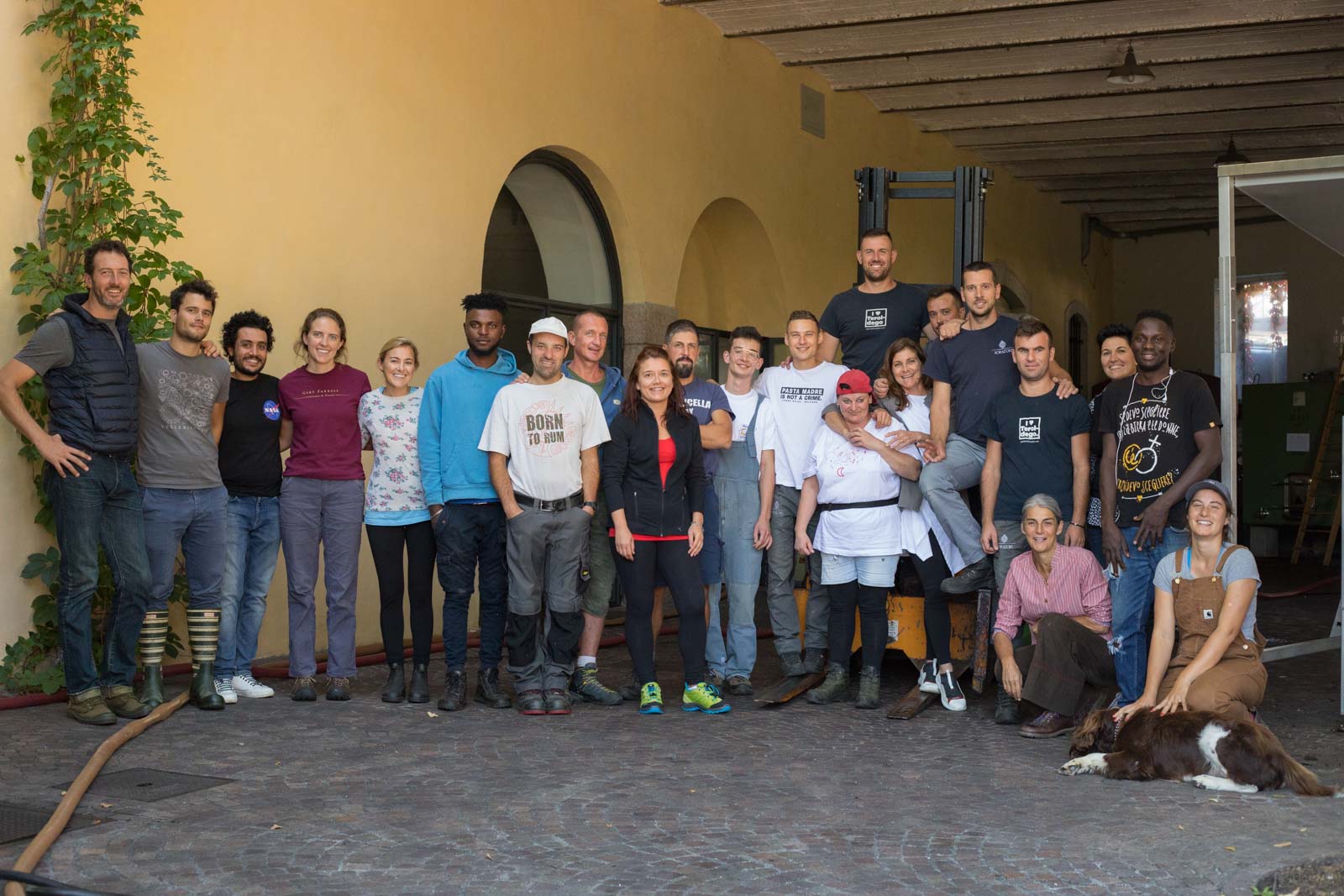
As Emilio takes the torch and faces the future, his mind is clearly focused on resilience: what will keep these vines healthy? What will help preserve the family legacy?
For me, I want to reserve judgement. I doubt I will ever be able to taste the impacts of a nearby vegetable garden in a wine. Nor will I revise my editorial standards and only review wines made from genetically diverse vineyards. (I’d lose all of my hair trying to tabulate such a thing).
All of that is beside the point. I care about wineries that aspire for a smaller footprint on their ecosystem. That want to capture nature’s voice as best as possible. And I certainly care about the preservation of a grape like Teroldego. If massal selection, biodynamic practices and co-planting provide evidence to the Foradori family that their vineyards are more resilient, and that the raw materials make more compelling wine — which our tasting certainly suggested — then I’ll be paying attention to Foradori wines for years to come. It would be nice to see Teroldego-as-we-know-it survive for a few more generations.
Tasting Report: Foradori Wines, 2018 Vintage
Next up, read my tasting report of the 2018 vintage at Foradori, featuring one of Italy’s most compelling white wines, as well as the iconic 2017 “Granato” Teroldego.

